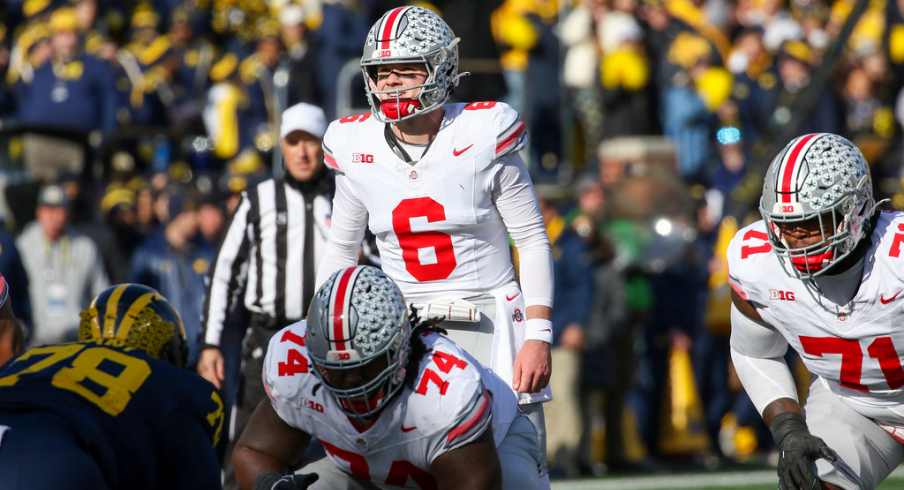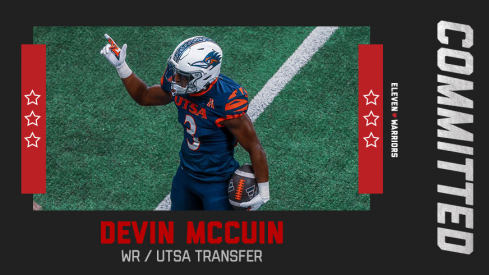Last Saturday, Ohio State outperformed its archrival in total yards, yards-per-play, first downs, and third-down conversions. Yet it still fell short in the metric that mattered most.
Despite what you may have read or heard, the outcome of this game was not decided by physical toughness or one program taking the rivalry more seriously. The difference, rather, was one team's ability to avoid mistakes while the other did not.
Unlike 2021, in which a core element of the OSU defense - an utter inability to stop the run - was exposed over and over again, the Buckeyes did not lose to That Team Up North last Saturday because of any foundational flaws. No, this loss came on the margins.
That fact has proven to hurt worse than it did in years past when a three-score loss seemed to make the solution vividly clear. Instead, this loss has only clouded the judgment of many within Buckeye Nation, resulting in anger and bitterness directed at all corners of the program.
It's not as if the Buckeyes hadn't learned from the past two losses to Michigan. After giving up 40+ points in each contest, Ryan Day and defensive coordinator Jim Knowles entered the game with a clear goal of forcing the Wolverines to earn every single yard that day, forcing them to string together long drive after long drive and limiting the big plays that had haunted them for the past year.
To do so, the Buckeyes played a heavy dose of Cover 4 (a.k.a. Quarters), which acted as a conservative pass coverage over the top, while also allowing safeties Josh Proctor and Sonny Styles to keep their eyes in the backfield and close quickly as extra defenders against the run.
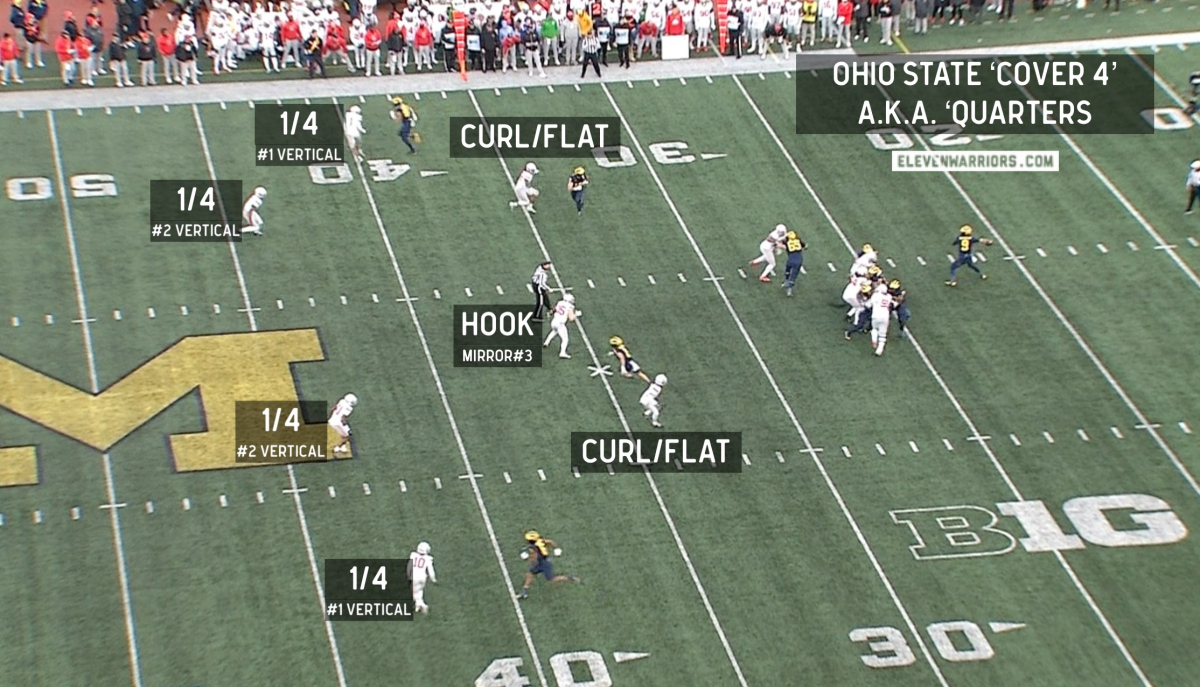
The concept was largely successful in limiting the Wolverines' big plays (more on that in a bit), allowing just four gains of 20+ yards and only one over 30. Overall, the home team finished with just 338 yards of total offense, its fourth-lowest output of the season and well below its average of 394 yards per game this fall.
The Maize & Blue passing game may not have been explosive, but was efficient enough to keep drives alive, however. Acting head coach Sherrone Moore and his staff quickly identified the Buckeyes' coverage tendencies and J.J. McCarthy delivered accurate balls to the weak spots in the zone, such as the flats outside the numbers.
The Michigan wideouts failed to create separation downfield thanks to the 'umbrella' coverage structure, but McCarthy consistently found his tight ends on stick routes and check-downs as the OSU linebackers struggled to cover so much space underneath.
Once the ball was caught, though, those same 'backers missed numerous tackles in the open field, allowing Colston Loveland and A.J. Barner to rack up 113 combined receiving yards with 61 coming after the catch.
When the Buckeyes forced their opponents into clear passing situations, they began mixing in man-coverage structures to take away those tight ends. Jordan Hancock and Styles were able to run with those tight ends while cornerbacks Denzel Burke and Davison Igbinosun blanketed the receivers outside.
Just as he did the year prior, however, McCarthy extended a number of plays in these situations and moved the chains by escaping the pocket and picking up yards with his feet on the rare occasion OSU defenders had their backs turned to him.
The QB run game would also gash the Buckeyes early in the second half when a surprise substitution saw backup Alex Orji pick up 20 yards on a Counter Bash concept that was reminiscent of the J.T. Barrett days in Columbus. It's worth noting that this is also one of the Baltimore Ravens' favorite schemes to run with Lamar Jackson. I wonder where they got the idea.
Of course, the Buckeyes weren't impenetrable against the traditional run game, either. Though they held running backs Blake Corum and Donovan Edwards to a combined average of just 3.7 yards per carry, they allowed Corum to find the end zone midway through the third quarter thanks to an untimely mistake.
Following the emotional injury to starting guard Zak Zinter, the Wolverines ran behind fullback Ben Bredeson on a simple, inside zone ISO play, with Corum following his lead blocker on the offense's right side. But Bredeson's pre-snap motion disguised which hole he'd lead through, affording linebackers Tommy Eichenberg and Steele Chambers little time to adjust their run fits accordingly.
When Bredeson led through the weak-side B-gap, Eichenberg quickly stepped up to take on the blocker and take away the running lane. But rather than stay in the strong A-gap, as was his responsibility, Chambers cheated over top to mirror the runner's initial path, only to see Corum bounce back through the now-open A-gap and run through Styles' lunging arm tackle.
Such small errors were exposed by Michigan throughout the game, with none bigger than the halfback pass that opened the fourth quarter.
The Wolverine coaches bet correctly that the Buckeye secondary would have its eyes on Edwards as he took a pitch outside, leaving Loveland alone to run downfield before hauling in a 34-yard gain; the longest play from scrimmage allowed all day by the visitors from Columbus.
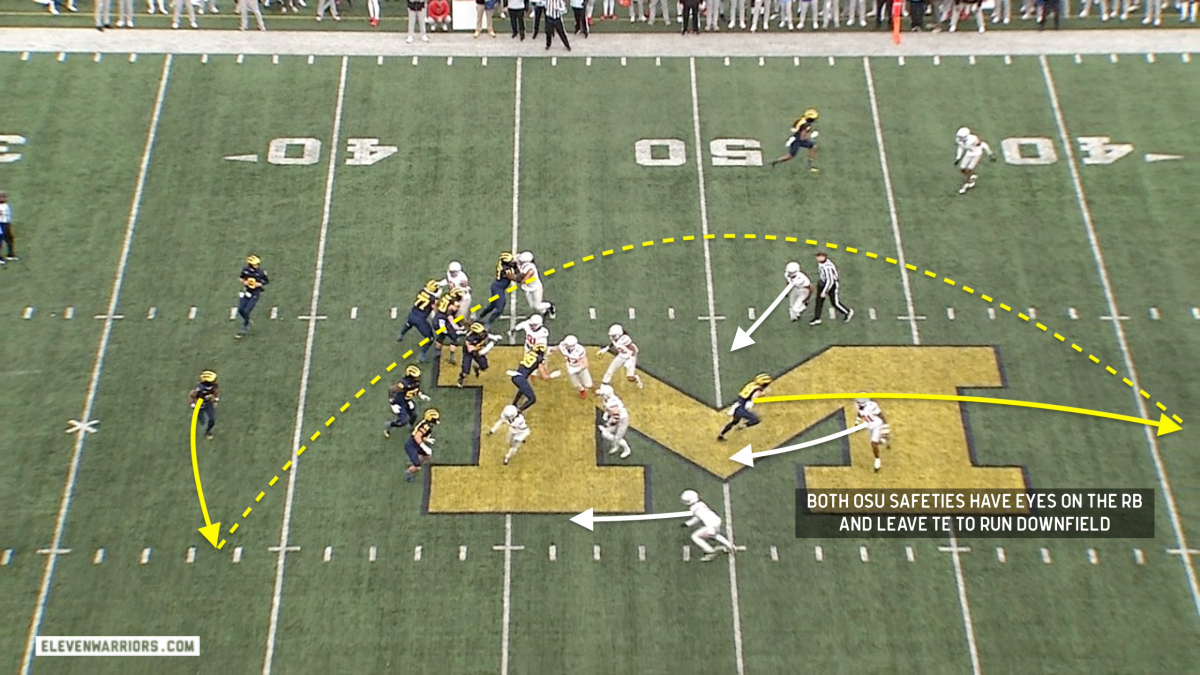
But after the halfback pass, the Buckeyes would only allow one gain of 10+ yards for the remainder of the game, forcing their opponents to grind out drives before kicking field goals. The 13-play, 56-yard drive in the fourth quarter has brought back many of the arguments about toughness and resolve, as OSU stuck with its game plan of keeping both safeties deep in their base, Cover 4 structure until only two minutes remained.
Of course, once Proctor and Styles lined up in the box, the Buckeye front had no trouble swallowing up the Wolverine run game, prompting many to wonder if Day and Knowles had waited too long to take such a risk. While the Buckeye defense proved capable of bottling up the opposition and eliminating big plays, one can't help but wonder what could have been if they'd been more aggressive on that long 4th quarter drive that bled so much clock.
Similarly, when Zinter exited the game, the Buckeyes didn't attack that reshuffled offensive line that saw right tackle Karsen Barnhart slide inside to guard. There were no stunts or blitzes to make life even more difficult along that side, just the same base, four-down front moving straight forward to fill every gap like a punt block unit in Madden.
While there may have been little creativity on the defensive side of the ball, the same can't said for Day's offense. As he's done all year long, the Buckeye head coach and play-caller put together a game plan that stressed the top-ranked Michigan defense, highlighted by a third-quarter touchdown drive that ended with eight consecutive run plays.
These runs weren't just examples of the OSU offensive line proving its toughness by moving the talented UM defensive tackles, they were well-designed, complementary concepts that kept the linebackers guessing. While everyone knows the Buckeyes prefer Wide Zone and Counter plays, Day mixed in other concepts to take advantage when the defense began over-playing one of those runs.
One such example was Zone Windback, in which the entire O-line steps laterally as if it were a wide zone run, only to wall off the interior as the running back takes the ball going straight ahead and looks for a cutback lane instantly. To help him, a wide receiver comes across the formation to seal the edge like a split-zone run.
With the addition of some eye candy to distract the back seven in the form of a different receiver running jet motion the other way, there were plenty of running lanes to be found in the second half along the vaunted interior of the nation's best defense.
But while the Buckeyes dug deep into the playbook to design a diverse running game, the Wolverines tapped into their NFL connections to create a game plan to minimize the best player on the field. Marvin Harrison Jr. may not be a Pro Bowler yet, but he got a preview of what he'll likely experience at the next level from Jesse Minter's defense.
While Vic Fangio may not have had a very successful head coaching tenure with the Broncos, his unique schematic approach has taken the league by storm. The static, two-high scheme, which has a great deal of post-snap movement, has quickly spread throughout the league by both Fangio's former assistants and the opposition alike, as it's proven capable of slowing some of the league's most explosive offenses and neutralizing star receivers.
Minter has coached at the collegiate level for the past three seasons but showed that he is clearly paying attention to the latest trends at the highest level. He wasn't shy about incorporating them in the biggest game of the year, specifically when it came to double-covering Harrison no matter where he lined up.
While Michigan would line up in a basic, two-high structure similar to the one Ohio State used throughout the afternoon, Fangio's variation of a Cover 2 'Cloud' would be called to whichever side Harrison was aligned. The concept, known as 'Zeus' for the zone-match iteration and 'Ring' in man-match, turns the defense into regular quarters (Cover 4), or versions of Quarter-Quarter-Half to the strong side (Cover 6), or to the weak (Cover 8) - all based on where the star receiver lines up.
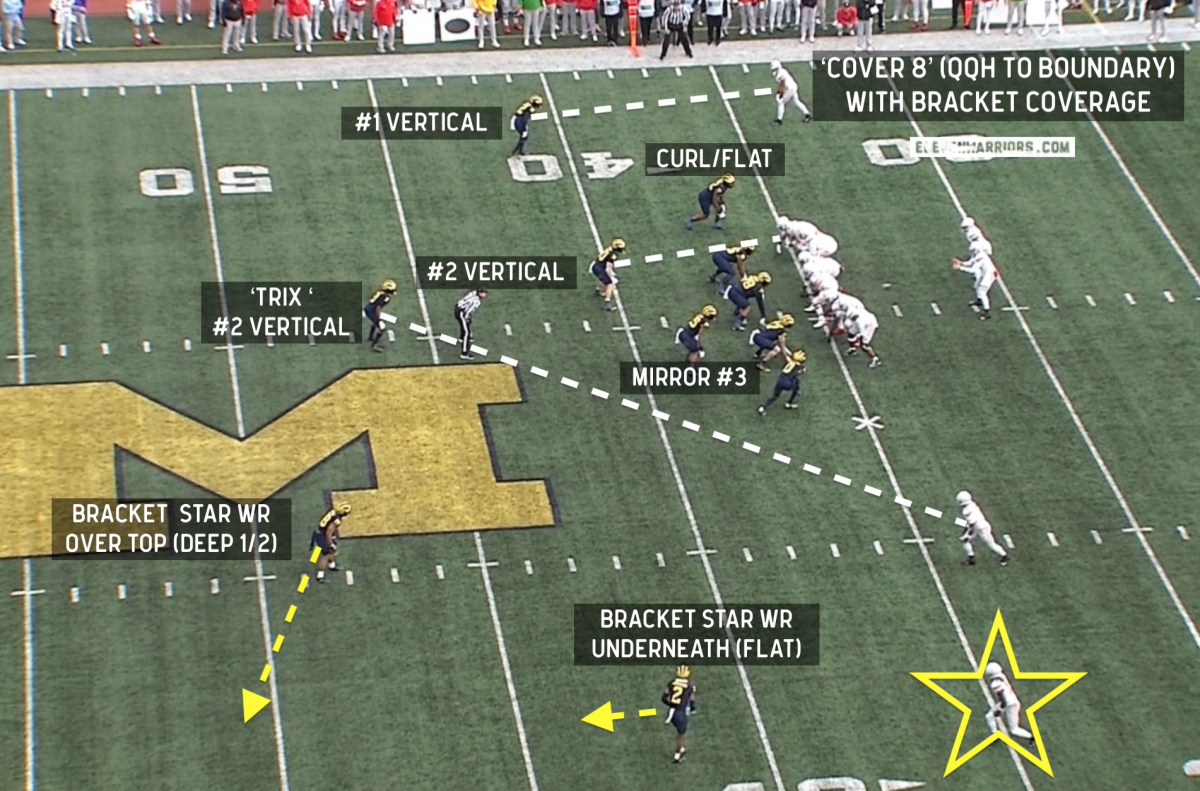
The result was a picture for Kyle McCord in which both safeties lined up on the hash marks before the snap, only to see one bail out and play a bastardized version of a deep half zone directly over the top of the star receiver. Meanwhile, the underneath defender aggressively played any short routes, knowing there would be help over the top.
The downside to such coverage is it leaves the defense exposed in one-on-one matchups against the rest of the offense's receivers. When McCord finally grew to recognize when and how this system worked, he delivered some nice throws down the field.
One of his best was a seam route to Cade Stover, who outran an overmatched linebacker tasked with covering him downfield.
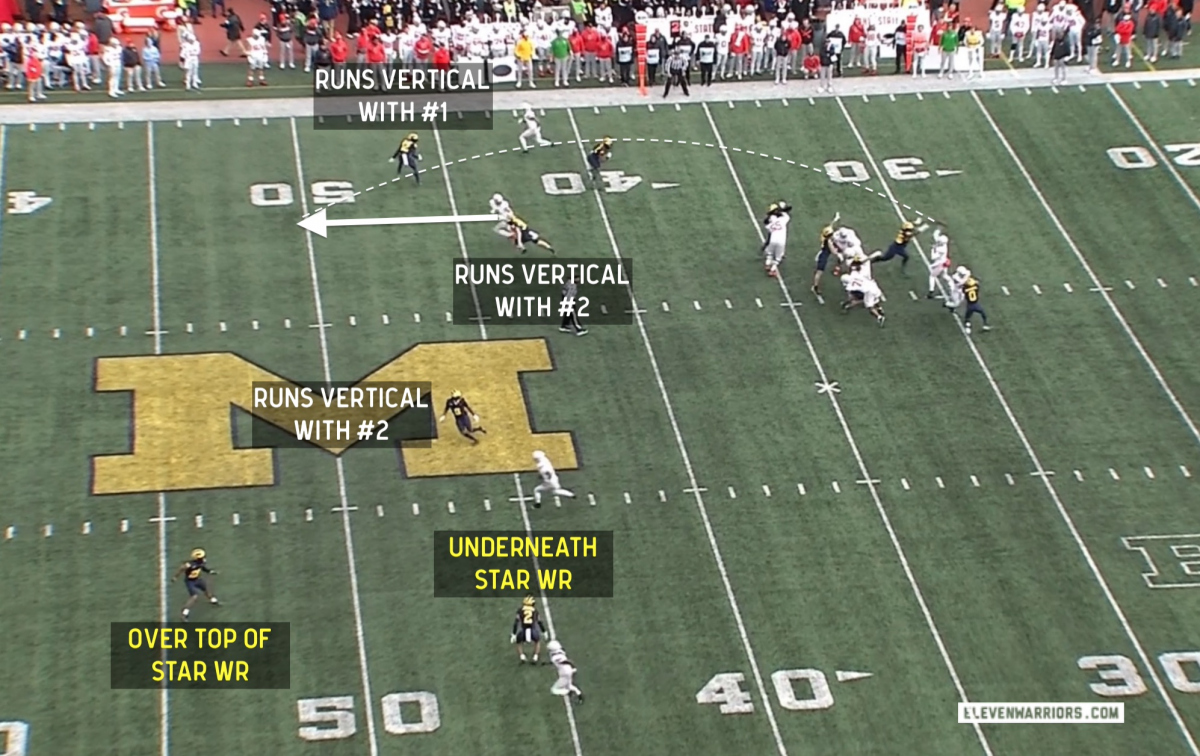
Of course, that throw came after the one that essentially decided the game, an early slant route that was jumped by cornerback Will Johnson and returned to the OSU 7-yard line. Though it would take all four downs, the Wolverines hammered the ball in over the goal line to put the Buckeyes in an early hole out of which they'd never climb.
While Johnson made a good play to jump the route, he was able to be ultra-aggressive thanks to the presence of the safety ten yards behind him in case Harrison turned the route into a double move. McCord, meanwhile, made a throw he'll forever want back.
While Harrison noted following the game that he had never experienced as much double coverage as he did that day, McCord seemed unsure, at times, of what coverage he was seeing while dropping back. Of course, that is the desired effect of employing such looks.
Even when going with tempo in hopes of catching the Wolverines in a more simplified coverage, Minter had answers. One of the most common was a similar bracket coverage, known as 2-Steal. With this variation on Cover 2 being executed behind a 5-man pressure, McCord seemed to panic and throw into windows that were never open.
As it has on numerous occasions this fall, this sense of panic had an effect on McCord's mechanics. Unsure of what he was seeing, he would hold the ball just an instant too long, allowing defenders to close windows that had initially looked open.
After throwing a slant behind Egbuka on the first drive of the game that would have resulted in a huge gain, he nearly put his second-best receiver in the injury tent on a vertical seam route that was thrown too late. Day had dialed up a four-verticals concept against a three-deep zone, and Egbuka might still be running had his QB thrown it after one hitch instead of two.
Despite the early hiccups, the Buckeyes stayed in the game thanks to their run game and the adjustments made to account for the unique double-coverage aimed at Harrison.
Coming out of halftime, the Buckeyes adjusted by motioning a second receiver to Harrison's side and running him right at the safety, effectively leaving the star receiver in solo coverage. Although McCord threw another inaccurate ball behind his target, the ultra-talented wideout showed why the defense was so worried about slowing him down.
To be clear, McCord made a number of very good throws throughout this game, including an early slot fade to Harrison that dropped perfectly out of the sky for a big gain. Never was 'Good Kyle' on display more than in the game's waning moments.
Just as he had late in the comeback win over Notre Dame, McCord looked like a different player when given the ball down six with a minute to play. With the entire season on the line, the junior from New Jersey made his best throw of the day, and maybe one of the best of the season.
After completing a 22-yarder to Harrison, McCord dropped back and saw Michigan doubling Harrison again. As he hitched up once and progressed to his second option, he saw the free safety taking away Egbuka's deep route up the seam. McCord properly hitched up one more time and uncorked a laser to his third read, Julian Fleming, hitting him right in the scarlet #4 on his jersey as he broke inside on a deep dig pattern.
The play would give OSU fans hope for a fleeting moment, although McCord's next, and final, pass would end up in the arms of a Michigan safety as it fluttered out of his hand.
But although McCord made a number of mistakes throughout this contest, his second interception was not his fault. Left guard Donovan Jackson stepped on the foot of the center, Carson Hinzman, while setting up in pass protection, losing his footing and allowing Jaylen Harrell to hit the QB just as he tried to throw to a (finally open) Harrison breaking inside on a dig route of his own.
Such mistakes were the story of the game, not because of their prevalence, but due to their rarity. The Buckeyes had a clearly superior Success Rate throughout the game, a measure that grades snaps on a play-by-play basis as a success or failure for each team. For the second straight year, Ohio State won more individual snaps, yet lost the game.
DID WE REALLY GET BEAT THAT BAD?
— parker fleming (@statsowar) November 27, 2023
Net Success Rates in Week 13 pic.twitter.com/E7HSqclmLl
The veteran Wolverines, featuring a roster littered with fourth and fifth-year players, made very few mistakes, committing just three penalties and no turnovers. McCarthy may have completed just two passes over ten yards in the air, but he also took care of the football and was sacked just once.

This difference in execution came to light on special teams as well, with the Wolverines hitting all three field goal opportunities and averaging 15 additional yards per punt. Buckeye kicker Jayden Fielding, of course, missed a crucial kick as time ran out on the first half.
The decision to kick that field goal at all has caused many to question Day's game management, as the Buckeyes faced 4th & 2 on a drive that had already gone 64 yards. That decision to burn 30 seconds and kick, along with his decision to punt on an early 4th & 1 situation, stood in stark contrast to Moore's decision to go for it on three separate 4th downs.
Day has now been on the receiving end of endless criticism since the game ended, and some of it is certainly warranted. But while we here at Film Study don't believe this performance merits his dismissal, it's evident that something has to change on the Buckeye coaching staff.
One year ago, in this very column, I suggested that Day give up full-time play-calling in order to focus more on game management in these critical moments. That doesn't mean he should hand over the offensive keys entirely to someone else, though.
Just as legendary coaches like Andy Reid with the Chiefs offense or Nick Saban with the Alabama defense still act as the foundational brain at the core of their ultra-successful systems, Day should absolutely continue to play a definitive role in what had been one of the nation's best offenses, year in and year out.
But when Kevin Wilson was replaced by former G.A., Keenan Bailey, the Buckeye brain trust now features three offensive coaches - Bailey (TEs), Corey Dennis (QB), & Brian Hartline (WR) - who are in their first jobs as position coaches. That puts an incredible amount of pressure on Day, especially given his history of being hands-on with the QB position.
While he surely trusts Dennis, who was a receiver at Georgia Tech before joining the OSU staff as an intern in 2015, McCord's mechanical issues are not due to a lack of talent, or can be addressed with goofy throwing drills over a broom. No, McCord is in dire need of the kind of QB-play caller connection that so clearly benefited his predecessors at the position.
Day, meanwhile, clearly hasn't been able to spend as much time working with the QB this season while balancing his other duties as play-caller, game manager, and program CEO. Despite featuring the most talented receiver in a generation, the Buckeyes finish the regular season with the nation's 38th-best offense, dropping out of the top ten for the first time since Day joined the staff in 2017. Even worse, his team finds itself in the same position it did a year ago.
Michigan, meanwhile, features a veteran coaching staff that maximizes the talent at hand and puts a team on the field that doesn't beat itself (the Wolverines enter the postseason as the least-penalized team in the nation). But that same staff has the depth and experience to put together a bespoke, cutting-edge game plan on defense while providing enough answers for Moore offensively that he never had to question whether or not to go for it on 4th & short.
Ohio State has had a more talented roster from top-to-bottom in each of the last three seasons. NFL draft picks prove that. But it's never been more apparent that their rivals in Ann Arbor feature more talent on the sidelines and in the booth, even when the head coach isn't present.
Getting rid of Day won't fix that problem, though. Instead, the program must insist that upgrades be made to the rest of the staff, which will allow its head coach to maximize his own potential, rather than continue to make him do everything.
